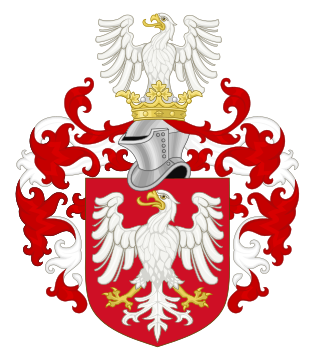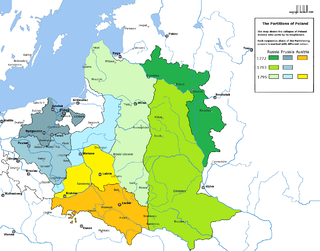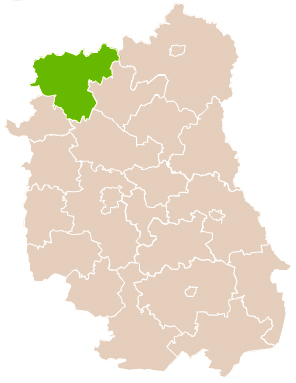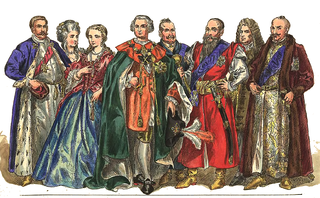
The Partitions of Poland were three partitions of the Polish–Lithuanian Commonwealth that took place toward the end of the 18th century and ended the existence of the state, resulting in the elimination of sovereign Poland and Lithuania for 123 years. The partitions were conducted by the Habsburg monarchy, the Kingdom of Prussia, and the Russian Empire, which divided up the Commonwealth lands among themselves progressively in the process of territorial seizures and annexations.

The House of Piast was the first historical ruling dynasty of Poland. The first documented Polish monarch was Duke Mieszko I. The Piasts' royal rule in Poland ended in 1370 with the death of king Casimir III the Great.

Płock Voivodeship was a unit of administrative division and local government in Poland from 1975 to 1998 and earlier from the 15th century till 1795. The more recent one was superseded by Łódź Voivodeship and Masovian Voivodeship.

South Prussia was a province of the Kingdom of Prussia from 1793 to 1807.

Ternopil Oblast, also referred to as Ternopilshchyna or Ternopillia, is an oblast (province) of Ukraine. Its administrative center is Ternopil, through which flows the Seret, a tributary of the Dniester. Population: 1,021,713.

The 1793 Second Partition of Poland was the second of three partitions that ended the existence of the Polish–Lithuanian Commonwealth by 1795. The second partition occurred in the aftermath of the Polish–Russian War of 1792 and the Targowica Confederation of 1792, and was approved by its territorial beneficiaries, the Russian Empire and the Kingdom of Prussia. The division was ratified by the coerced Polish parliament (Sejm) in 1793 in a short-lived attempt to prevent the inevitable complete annexation of Poland, the Third Partition.

The Third Partition of Poland (1795) was the last in a series of the Partitions of Poland–Lithuania and the land of the Polish–Lithuanian Commonwealth among Prussia, the Habsburg monarchy, and the Russian Empire which effectively ended Polish–Lithuanian national sovereignty until 1918. The partition was the result of the Kościuszko Uprising and was followed by a number of Polish uprisings during the period.

Włoszczowa(listen) is a town in southern Poland, in Świętokrzyskie Voivodeship, about 50 kilometres west of Kielce. It is the capital of Włoszczowa County. Population is 10,756 (2004). Włoszczowa lies in historic Lesser Poland, and from its foundation until 1795, it belonged to Sandomierz Voivodeship. The town has the area of 30 km2, and is a junction of regional roads nr 786, nr 742, and 785. Włoszczowa has two rail stations: PKP Włoszczowa, and PKP Włoszczowa Północ.

Łuków County is a unit of territorial administration and local government (powiat) in Lublin Voivodeship, eastern Poland. It was established on January 1, 1999, as a result of the Polish local government reforms passed in 1998. Its administrative seat and largest town is Łuków, which lies 76 kilometres (47 mi) north of the regional capital Lublin. The only other town in the county is Stoczek Łukowski, lying 30 km (19 mi) west of Łuków.

Polish nationalism is a form of nationalism which asserts that the Poles are a nation and promotes the cultural unity of Poles. Norman Davies, in the context of Polish nationalism, generally defined nationalism as "a doctrine ... to create a nation by arousing people's awareness of their nationality, and to mobilize their feelings into a vehicle for political action".

Following three consecutive partitions of Poland carried out between 1772 and 1795, the sovereign state known as the Polish–Lithuanian Commonwealth disappeared from the map of Europe. In 1918 following the end of World War I, the territories of the former state re-emerged as the states of Poland and Lithuania among others. In the intervening period, the territory of the former Polish–Lithuanian Commonwealth was split between the Austrian Empire, the Kingdom of Prussia and the Russian Empire. These powers subdivided the territories that they gained and created new toponyms for the territories conquered. The subdivisions created were complicated by changes within those empires as well as by the periodic establishment of other forms of the quasi-Polish provinces led by a foreign head of state.

Polish–French relations are relations between the nations of France and Poland, which date back several centuries.

The Austrian Partition comprises the former territories of the Polish–Lithuanian Commonwealth acquired by the Habsburg monarchy during the Partitions of Poland in the late 18th century. The three partitions were conducted jointly by the Russian Empire, the Kingdom of Prussia and Habsburg Austria, resulting in the complete elimination of the Polish Crown. Austria acquired Polish lands during the First Partition of 1772, and Third Partition of Poland in 1795. In the end, the Austrian sector encompassed the second-largest share of the Commonwealth's population after Russia; over 2.65 million people living on 128,900 km2 of land constituting the formerly south-central part of the Republic.

The Prussian Partition, or Prussian Poland, is the former territories of the Polish–Lithuanian Commonwealth acquired during the Partitions of Poland, in the late 18th century by the Kingdom of Prussia. The Prussian acquisition amounted to 141,400 km2 of land constituting formerly western territory of the Commonwealth. The first partitioning led by imperial Russia with Prussian participation took place in 1772; the second in 1793, and the third in 1795, resulting in Poland's elimination as a state for the next 123 years.

The Russian Partition, sometimes called Russian Poland, constituted the former territories of the Polish–Lithuanian Commonwealth that were annexed by the Russian Empire in the course of late-18th-century Partitions of Poland. The Russian acquisition encompassed the largest share of Poland's population, living on 463,200 km2 of land constituting the eastern and central territory of the former commonwealth. The three partitions, which took place in 1772, 1793 and 1795, resulted in the complete loss of Poland's sovereignty, with its territory split between Russia, Prussia and Austria. The Napoleonic Wars saw significant parts of Prussia's and Austria's partitions reconstituted as the Duchy of Warsaw, most of which was then reconstituted as the Kingdom of Poland within the Russian Empire in 1815.

The magnates of Poland and Lithuania were an aristocracy of Polish-Lithuanian nobility (szlachta) that existed in the Crown of the Kingdom of Poland, in the Grand Duchy of Lithuania and, from the 1569 Union of Lublin, in the Polish–Lithuanian Commonwealth, until the Third Partition of Poland in 1795.





























